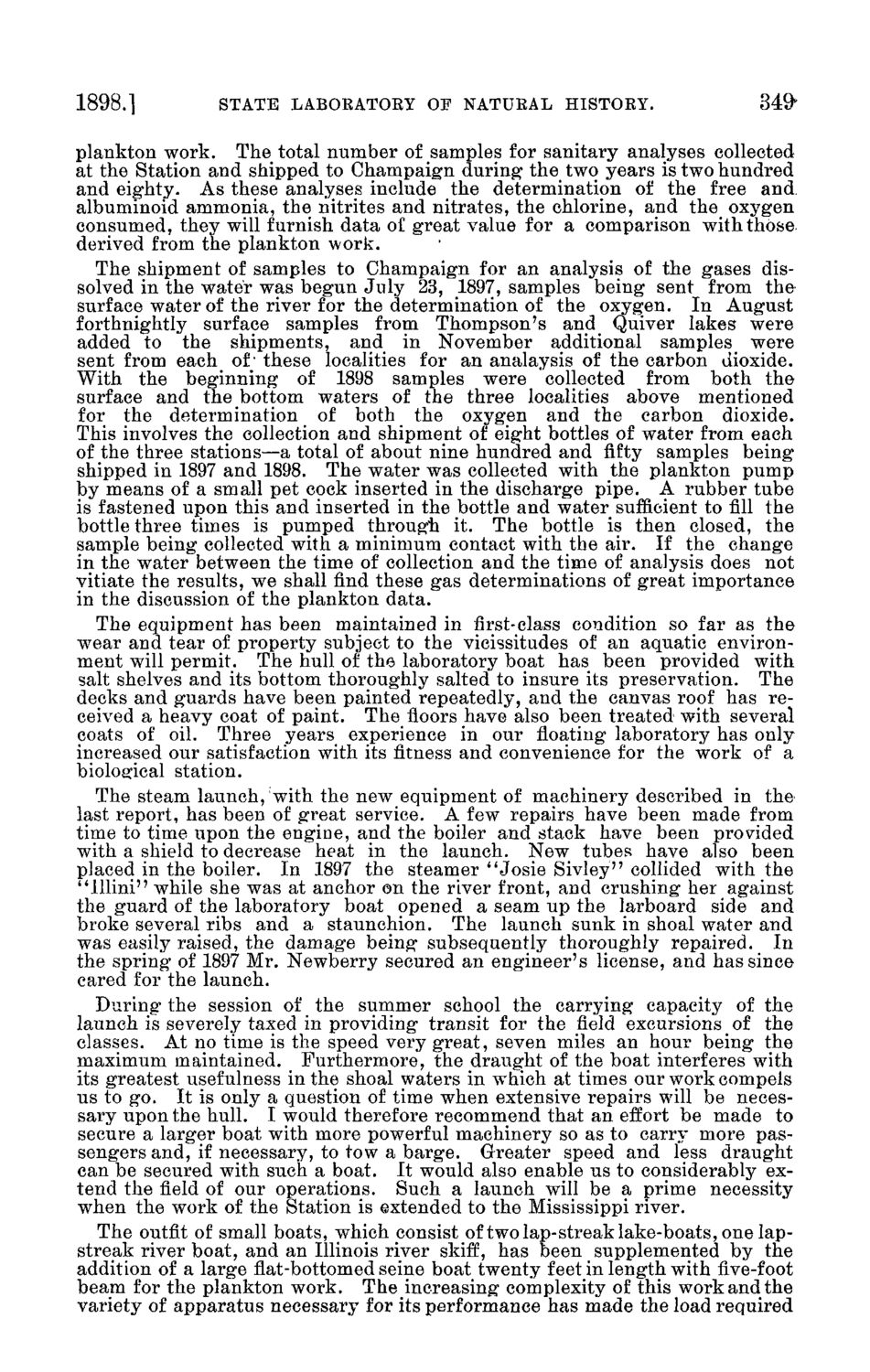| |
| |
Caption: Board of Trustees Minutes - 1898
This is a reduced-resolution page image for fast online browsing.

EXTRACTED TEXT FROM PAGE:
1898.] STATE LABORATORY OF NATURAL HISTORY. 34& plankton work. The total number of samples for sanitary analyses collected at the Station and shipped to Champaign during the two years is two hundred and eighty. As these analyses include the determination of the free and albuminoid ammonia, the nitrites and nitrates, the chlorine, and the oxygen consumed, they will furnish data of great value for a comparison with those derived from the plankton work. The shipment of samples to Champaign for an analysis of the gases dissolved in the water was begun July 23, 1897, samples being sent from the surface water of the river for the determination of the oxygen. In August forthnightly surface samples from Thompson's and Quiver lakes were added to the shipments, and in November additional samples were sent from each of; these localities for an analaysis of the carbon dioxide. With the beginning of 1898 samples were collected from both the surface and the bottom waters of the three localities above mentioned for the determination of both the oxygen and the carbon dioxide. This involves the collection and shipment of eight bottles of water from each of the three stations—a total of about nine hundred and fifty samples being shipped in 1897 and 1898. The water was collected with the plankton pump by means of a small pet cock inserted in the discharge pipe. A rubber tube is fastened upon this and inserted in the bottle and water sufficient to fill the bottle three times is pumped through it. The bottle is then closed, the sample being collected with a minimum contact with the air. If the change in the water between the time of collection and the time of analysis does not vitiate the results, we shall find these gas determinations of great importance in the discussion of the plankton data. The equipment has been maintained in first-class condition so far as the wear and tear of property subject to the vicissitudes of an aquatic environment will permit. The hull of the laboratory boat has been provided with salt shelves and its bottom thoroughly salted to insure its preservation. The decks and guards have been painted repeatedly, and the canvas roof has received a heavy coat of paint. The floors have also been treated with several coats of oil. Three years experience in our floating laboratory has only increased our satisfaction with its fitness and convenience for the work of a biological station. The steam launch, with the new equipment of machinery described in the last report, has been of great service. A few repairs have been made from time to time upon the engine, and the boiler and stack have been provided with a shield to decrease heat in the launch. New tubes have also been placed in the boiler. In 1897 the steamer "Josie Sivley" collided with the "Illini" while she was at anchor on the river front, and crushing her against the guard of the laboratory boat opened a seam up the larboard side and broke several ribs and a staunchion. The launch sunk in shoal water and was easily raised, the damage being subsequently thoroughly repaired. In the spring of 1897 Mr. Newberry secured an engineer's license, and has since cared for the launch. During the session of the summer school the carrying capacity of the launch is severely taxed in providing transit for the field excursions of the classes. At no time is the speed very great, seven miles an hour being the maximum maintained. Furthermore, the draught of the boat interferes with its greatest usefulness in the shoal waters in which at times our work compels us to go. It is only a question of time when extensive repairs will be necessary upon the hull. I would therefore recommend that an effort be made to secure a larger boat with more powerful machinery so as to carry more passengers and, if necessary, to tow a barge. Greater speed and less draught can be secured with such a boat. It would also enable us to considerably extend the field of our operations. Such a launch will be a prime necessity when the work of the Station is extended to the Mississippi river. The outfit of small boats, which consist of two lap-streak lake-boats, one lapstreak river boat, and an Illinois river skiff, has been supplemented by the addition of a large flat-bottomed seine boat twenty feet in length with five-foot beam for the plankton work. The increasing complexity of this work and the variety of apparatus necessary for its performance has made the load required
| |